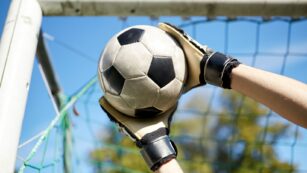In the world of soccer, the goalkeeper stands as the last line of defense, a position that demands a unique blend of skills and mental fortitude. Mastering the art of goalkeeping goes beyond just shot-stopping; it involves agility, positioning, and quick decision-making. With the right training, a goalkeeper can transform into a formidable force on the field.
Goalkeeper Skills Training
Goalkeeper skills training focuses on developing essential abilities that enhance performance in the goal. Training covers various areas, including shot-stopping, positioning, distribution, and communication.
Diving Techniques and Ball Control
 Diving is essential for effective shot-stopping. Practicing various diving techniques, such as the low dive for shots aimed at the corners and the high dive for overhead attempts, prepares goalkeepers for diverse situations. Drills that focus on proper technique, including hand positioning and body alignment, improve efficiency. Repetition of these drills under pressure simulates real-game conditions, allowing goalkeepers to react instinctively.
Diving is essential for effective shot-stopping. Practicing various diving techniques, such as the low dive for shots aimed at the corners and the high dive for overhead attempts, prepares goalkeepers for diverse situations. Drills that focus on proper technique, including hand positioning and body alignment, improve efficiency. Repetition of these drills under pressure simulates real-game conditions, allowing goalkeepers to react instinctively.
Ball control is crucial for maintaining possession and initiating attacks. Goalkeepers should practice handling various ball types, focusing on both catching and distributing effectively. Techniques such as the scoop, collapse catch, and punch-out methods help deal with different circumstances, like low shots or difficult bounces. Regular drills that emphasize footwork and reflexes enhance a goalkeeper’s ability to control the ball quickly, allowing smoother transitions during gameplay.
Positioning
Positioning significantly influences a goalkeeper’s effectiveness. Developing a sense of when to advance or hold back relative to the ball and attackers is vital. Goalkeepers practice general positioning through drills that simulate different shot angles and scenarios. Awareness of the goal’s dimensions and an understanding of the attacking player’s movements improve decision-making. Using cone drills to visualize optimal positions enhances this skill, ensuring goalkeepers are well-prepared to respond.
Effective Training Drills
Effective training drills enhance a goalkeeper’s skills, ensuring they develop crucial techniques needed during matches. By focusing on specific areas, goalkeepers improve their performance and instinctive reactions.
Warm-Up Exercises
 Warm-up exercises prepare the body and mind for training. Incorporating light jogging, dynamic stretching, and mobility drills enhances flexibility and reduces injury risks.
Warm-up exercises prepare the body and mind for training. Incorporating light jogging, dynamic stretching, and mobility drills enhances flexibility and reduces injury risks.
-
Jogging: Light jogging for five to ten minutes increases blood flow to muscles.
-
Dynamic Stretching: Leg swings, arm circles, and torso twists promote warmth and flexibility.
-
Footwork Drills: Ladder drills and cone weaving improve agility and quickness.
Reaction Time Drills
Reaction time drills boost a goalkeeper’s quickness and responsiveness. These fast-paced exercises simulate game conditions, enhancing reflexes during sudden plays.
-
Ball Toss with Random Directions: Partner tosses a ball in various directions, requiring quick foot placement and catching.
-
Reaction Balls: Utilizing reaction balls adds unpredictability, forcing goalkeepers to adapt their movements swiftly.
-
Goalkeeper Wars: Two goalkeepers take turns shooting at a small goal, challenging each other’s reaction times and shot-stopping abilities.
Handling and Distribution Drills
 Handling and distribution drills focus on ball control and accurate distribution methods. Mastery of these skills allows goalkeepers to enhance team play and execute quick transitions.
Handling and distribution drills focus on ball control and accurate distribution methods. Mastery of these skills allows goalkeepers to enhance team play and execute quick transitions.
-
Close-Range Catching Exercises: Partner practice with rapid-fire shots at close range develops catching confidence and hand positioning.
-
Distribution from Feet: Goalkeepers practice goal kicks and throws under pressure, aiming for precise targets on the field.
-
Punting Drills: Repeated punting with focus on distance and accuracy trains leg strength and technique for long balls.
Measuring Progress
 Improving a goalkeeper’s skills is a continuous journey that requires dedication and consistent effort. As training progresses it’s essential to regularly assess performance through drills and match scenarios. This not only helps in identifying strengths but also highlights areas needing improvement.
Improving a goalkeeper’s skills is a continuous journey that requires dedication and consistent effort. As training progresses it’s essential to regularly assess performance through drills and match scenarios. This not only helps in identifying strengths but also highlights areas needing improvement.
Setting specific goals for each training session can provide a clear path for development. Whether it’s mastering a new shot-stopping technique or enhancing communication with defenders tracking progress is crucial.
Incorporating feedback from coaches and peers can further refine skills and boost confidence. Ultimately a well-rounded approach to training ensures goalkeepers are prepared to handle the challenges of the game while contributing effectively to their team’s success.

